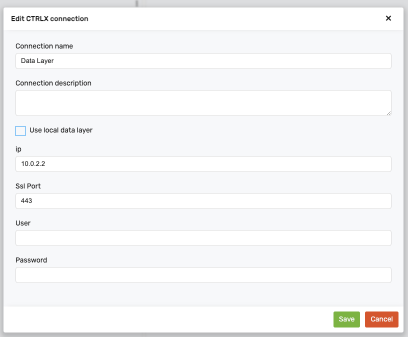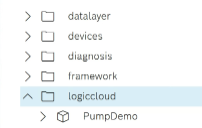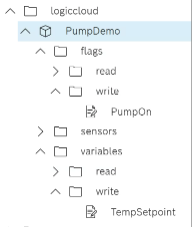ctrlX
If your logiccloud Control Runtime is running on a Bosch Rexroth ControlX system, you can control the inputs and outputs via the ctrlX connection. To do this, a new connection of type ctrlX must be created.
Connections can be either using the local (on-device) data layer or a remote data layer.
Connection name: Name of the connectionConnection description: Description of the connection
When using a local data layer connection, the Use local data layer checkbox must be checked.
For remote data layer connections, the Use local data layer checkbox must be unchecked and the following fields must be filled in:
Ip: IP address of the data layerSslport: SSL port used to connect to the data layer APIUser: Data layer user namePassword: Data layer password

Exposing variables to the data layer
For exposing process variables (either for reading or for writing), a provider configuration must be set up:

A provider configuration will create an entry in the data layer tree. The fields must be set up as follows:
Name: The provider nameDescription: The provider descriptionAddress: The path in the data layer tree where the provider node will be created. The address is a series of strings separated by the ‘/’ (forward slash character). Each segment of the address will correspond to a level in the tree.
At runtime, the address will create a similar structure in the data layer tree:

Mapping variables
The process variables can be mapped to variables from the ctrlX data layer via the mappings. To do this, either add individual variables or import inputs/outputs.


Variablename: Name of the process variableAddress: Address of the variable in the data layer. This address is relative to the provider address and it will create a subtree structure under the provider node based on the address elements. The address consists of a series of strings separated by the ‘/’ (forward slash) character. Each segment of the address will correspond to a level in the tree.Type: Data type of the variable in the data layerMode: Selection of whether process variables are written to the data layer or read from the data layer.
Consuming variables from the data layer
If the runtime must connect to values provided by other services into the data layer, then a client must be configured in the connection:
Name: the client nameDescription: the client description
Mapping variables
The process variables can be mapped to variables from the ctrlX data layer via the mappings. To do this, either add individual variables or import inputs/outputs.
Variable name: Name of the process variableAddress: Address of the variable in the data layer. This address must contain the full path of the variable. The address consists of a series of strings separated by the ‘/’ (forward slash) character.